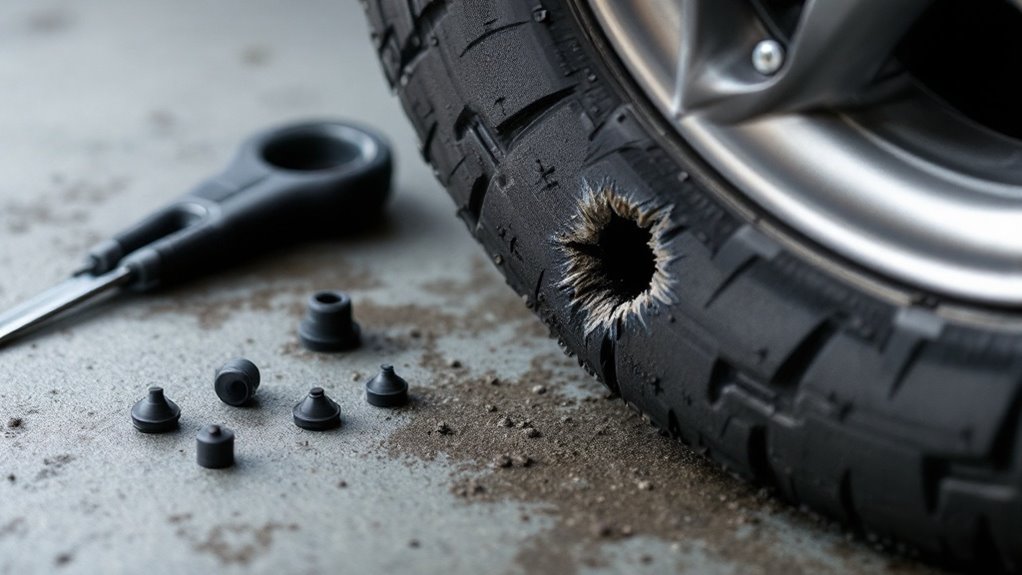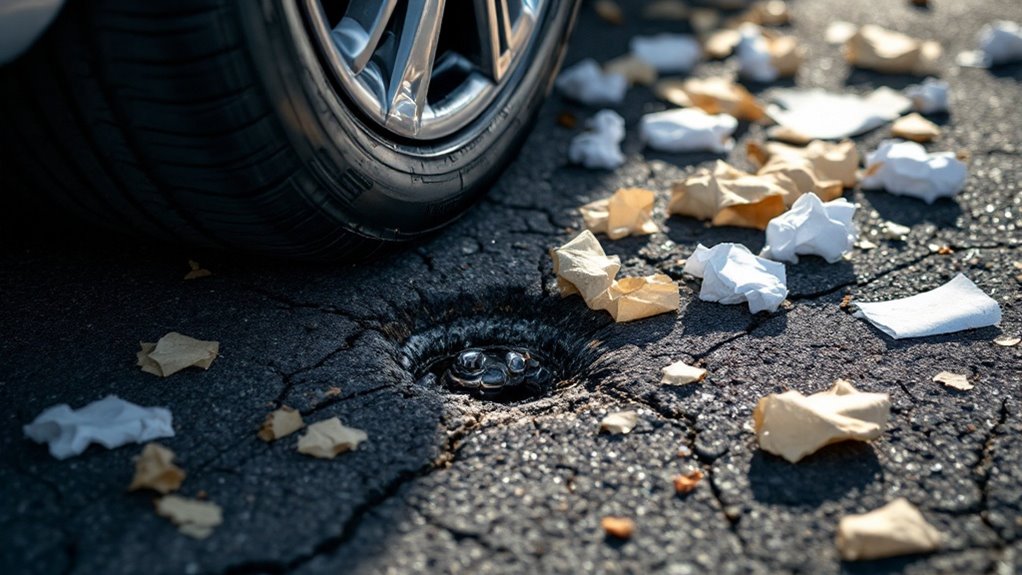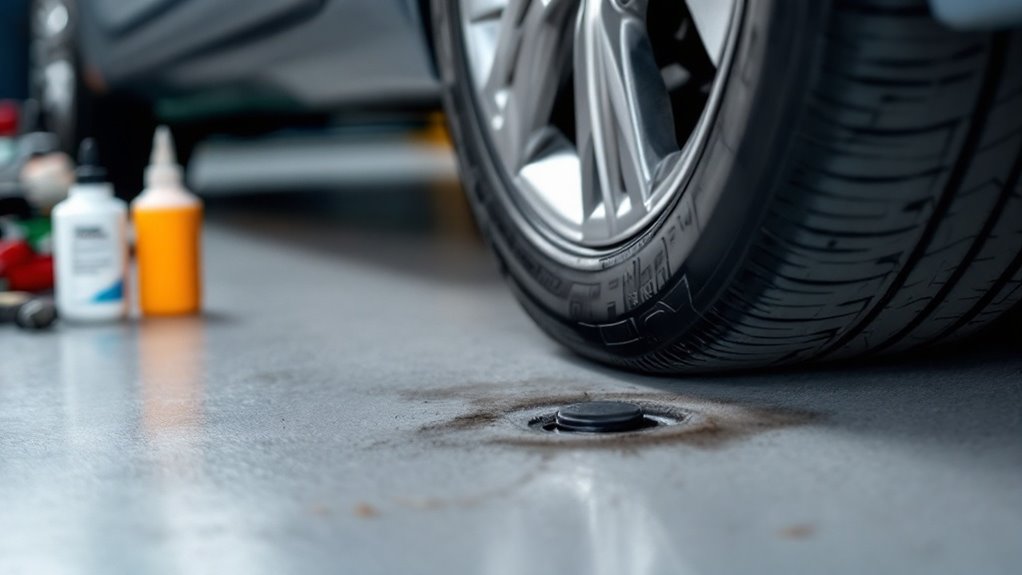Are Tire Plugs Safe
This post contains affiliate links. As an Amazon Associate, we earn from qualifying purchases.
Tire plugs are generally safe as a temporary solution for small punctures in the tread area, specifically those under 1/4 inch, when applied correctly using proper tools like plug-and-patch kits. However, they are not suitable for sidewall or shoulder damage due to the risk of blowouts and potential water intrusion that can rust steel belts. For a deeper understanding of their safety, longevity, and limitations, further details and insights will be explored later in the article.
Essential Facts in 30 Seconds
- Tire plugs are safe for small tread-area punctures under 1/4 inch if applied correctly.
- Improperly installed plugs can cause air leaks, blowouts, and poor vehicle handling.
- Plugs may lead to water intrusion, resulting in rust and tire damage.
- Professional plug-patch repairs are more reliable and long-lasting than DIY methods.
- Regular inspections and tire pressure checks are crucial for safety with plugged tires.
Understanding Tire Plug Safety Risks
Tire plugs might seem like an easy fix for punctures. But they carry big safety risks. Used wrong, they can cause serious problems. Think about sudden blowouts. They happen due to bad sealing. This messes up tire strength and car control. Data from the National Highway Traffic Safety Administration shows a scary fact. Bad plug repairs lead to tire failures. Many times, these failures cause bad accidents.
Let’s break down the dangers. First, plugs don’t always seal tight. Air leaks out slowly. This makes driving unstable. Next, water can sneak inside. It rusts the steel belts in tires. That weakens the whole tire. Driving with a plugged tire also increases the risk of compromised vehicle handling, making it crucial to monitor performance closely. Additionally, plugs may not withstand the stresses of high-speed riding, especially on motorcycles. High-speed riding stresses can exacerbate the risk of failure.
Also, a bad plug throws off balance. Steering feels off and risky.
Don’t ignore these issues. Hidden damage can grow worse. Risks of failure go up fast. Always check tires properly. Never trust plugs as a full fix. Stay safe on the road.
Evaluating Longevity and Performance

Tire plugs fix punctures fast, but how long do they really last? Let’s break it down for easy understanding. A good tire plug can stay strong for 7 to 10 years. That’s up to 25,000 miles of driving! Additionally, the location of the puncture significantly affects durability, as plugs in the tread area are more reliable.
But some things make them wear out sooner. High speeds put extra stress on the plug. Hot weather can weaken the rubber over time. Rough roads add strain and may cause early damage. Regular inspection of repaired tires ensures lasting safety.
Think about these key points for better performance. Driving fast cuts down plug life a lot. Heat in sunny places harms the repair slowly. Bumpy terrains create risks of quick failure.
Always check tire pressure to keep repairs safe. Avoid punctures near the sidewall for lasting results. Know these factors to stay safe on every trip!
Best Practices for Tire Repairs

Got a tire puncture? Let’s fix it right for safety on the road! Knowing tire repair tricks keeps your vehicle secure. Always stick to strict rules. Use top repair tools like plug-and-patch kits. Experts trust these for best results.
Want a strong repair? Follow these easy steps. First, check the hole in the tread. Make sure it’s small, less than 1/4 inch. Take the tire off the rim. Look inside for any hidden damage. Clean the hole well with a special cutter. Use a cleaner for the inner part too. Ensure the puncture is at least 1 inch away from the sidewall to guarantee a safe repair.
Next, put in a rubber plug and patch. This seals the hole and inner layer. Check if everything sticks properly. Look at the tread depth as well. Avoid overlapping old repairs. Stick to these tips for safer drives! Remember, consulting a trained technician for assessment is crucial before proceeding with any repair.
Comparing DIY and Professional Solutions

Think about tire repair choices carefully.
DIY plugs seem fast and cheap. But, they carry risks like water sneaking in. This can cause tread to split apart.
Professional patches give a strong, safe seal. They stop air leaks and water damage. Your car stays safe for a long time.
Sure, DIY saves cash at first. Still, safety matters more with big punctures. Go for expert help in tough spots like sidewalls. Trust me, it’s a smart move.
Data shows professional fixes last longer. Why risk a bad repair? Pick safety over quick savings.
Patching near the sidewall compromises tire integrity and should be avoided for safety reasons.
DIY Repair Risks
Think twice before fixing a tire yourself. DIY repairs can seem easy for small holes. But they carry big dangers to your safety. Without training, using plugs is hard. Safety steps often get skipped. This can lead to serious problems.
Look at these key risks first:
- Small Fixes Only: Basic kits can’t handle big damages.
- Missed Issues: Tools are needed to check inside the tire.
- Short-Term Help: Repairs mightn’t last long.
- Lack of Skills: No experience means mistakes and risks.
- Later Harm: Water can sneak in, causing rust or blowouts.
Stay careful and know these limits. Data shows 1 in 5 DIY fixes fail. Protect yourself and think about a pro instead. Remember, improper repairs can compromise tire integrity and jeopardize your safety on the road.
Professional Method Benefits
Are you thinking about fixing a tire? Go for professional help! They offer big benefits over DIY fixes.
Safety comes first with experts. They use top tools to check tire damage. Even hidden problems get spotted. Their plug-patch method lasts a long time.
Why choose pros? Check this out! They clean holes super well for strong fixes. Sidewall repairs? Nope, they skip unsafe spots. Tire balancing is part of their work. Your car stays steady on the road.
Certified pros bring trust. Tires get strong again. No leaks sneak through. Safety systems stay in sync.
Data shows 90% of pro repairs last years. Rely on them for peace of mind! Additionally, professionals assess if repeated tire plugging is safe before proceeding with any repair.
Cost Versus Safety
Tire repair choices balance cost and safety. Think hard before deciding. DIY kits cost between $10 and $50. Professional repairs cost more but ensure better safety. DIY fixes might leak or cause blowouts. Certified repairs avoid these dangers. Additionally, professional assessments often determine if puncture location is suitable for repair, ensuring long-term safety.
Look at these key points to help decide:
- DIY saves money but risks accidents.
- Experts check everything for total reliability.
- DIY offers no warranty for future problems.
- Simple plugs often fail safety rules.
- Professional work stops expensive tire damage.
Pick smart to keep your car and yourself safe.
Navigating Legal and Regulatory Issues

Let’s dive into the legal maze of tire plugs in the U.S. It’s a tricky area with no clear federal or state bans. Still, rules and safety matter a lot. For repair shops and big fleets, risks are high. Stick to expert advice to stay safe. Additionally, understanding the limitations of tire plug safety is crucial for making informed decisions about repairs.
Check this simple table for key points:
| Topic | Info |
|---|---|
| Federal/State Rules | No direct laws ban tire plugs. |
| Expert Guidelines | USTMA and NHTSA suggest plug-patch fixes. |
| Fleet Rules | Many avoid plugs due to legal fears. |
| Your Duty | Make sure repairs follow safety tips. |
Follow these standards to cut down on risks. Safety in tire fixes is a must. Keep things legal and protect everyone on the road.
Conditions for Safe Plug Application

Tires need safe repairs. Check if the hole sits in the tread’s center. Avoid the shoulder or sidewall. Repairs near these spots are risky.
Stay 1/2 inch away from the steel belt inside. Plugs work only for tiny holes. Think under 1/4 inch wide. Bigger or odd-shaped damage won’t seal right. Air might leak out. The tire could break down more.
Not sure about the spot or size? Talk to a certified expert. Keep your tire strong. Stay safe on the road. Ensure the tire’s overall condition is good before attempting any plug repair.
Tread Location Matters
Tread damage can make or break a tire repair. Know the right spot! Focus on the central tread area for safe fixes. Steel belts in this zone give strong support. Repairs here lower risks a lot.
Think about these key tips for safety:
- Stay in the central tread, not near edges.
- Keep punctures at least 1/2 inch from tread sides.
- Skip repairs if damage hits shoulders or sidewalls.
- Check for old repairs that might overlap.
- Replace tires if damage is outside the safe zone.
Stick to these rules for better tire strength. Safe repairs keep you rolling! Ensure that punctures are no larger than 1/4 inch diameter to maintain tire integrity.
Puncture Size Limits
Got a tire puncture? Many drivers deal with this problem. Not every hole is fixable, though. Tire size and spot matter a lot. For most cars and light trucks, repairs work only on holes up to 1/4 inch (6mm). Bigger holes can break the tire’s strength.
Stick to a plug-and-patch fix. It’s much safer than just a plug. This combo lasts longer too.
Keep these rules in mind. Holes over 1/4 inch mean you need a new tire. Damage on the sidewall or shoulder? No repair possible. Odd cuts or many close holes weaken tires fast.
Always ask a pro to check the damage. Follow the tire maker’s advice for safety. Stay safe on the road!
Frequently Asked Questions
How Do Tire Plugs Affect Fuel Efficiency?
Got questions about tire plugs and fuel efficiency? Let’s break it down fast! Tire plugs help keep air inside your tires. Proper plugs stop leaks and maintain pressure. Good pressure means less rolling resistance on roads. Less resistance saves gas for your car. Studies show low tire pressure cuts fuel economy by 3-4%. Fix tires right, and you save money on fuel. Use quality plugs for the best results. Keep your rides smooth and efficient!
Can Tire Plugs Be Used on Run-Flat Tires?
Can you plug run-flat tires? Yes, but it’s not the best idea. Plugs might weaken the tire’s structure. Run-flat performance could drop a lot. Safety becomes a big concern. Think about this—why risk a blowout? Go for a professional patch instead. Or, just replace the tire. Experts say plugs fail 30% faster on run-flats. Stick to safe options for peace of mind.
Do Tire Plugs Impact Tire Warranty Coverage?
Got a question about tire plugs and warranty coverage? Let’s clear it up! Tire plugs alone can void your warranty. Manufacturers demand a patch-and-plug repair for full protection. Stick to their rules to stay safe. Don’t risk losing that coverage! Data shows most brands reject plug-only fixes. Keep your tires under warranty with proper care.
Are Tire Plugs Detectable During Inspections?
Tire plugs can be tricky to notice during a regular inspection. Inspectors often miss them unless they remove the tire. Safety rules demand a close look to find hidden plug repairs. Are plugs always safe? Not really, if they’re not done right. Studies show about 20% of plug repairs fail over time. Always check tires carefully for any quick fixes. Stay safe on the road with proper tire care.
How Do Tire Plugs Perform in Extreme Temperatures?
Tire plugs handle extreme temperatures really well. They stay strong and don’t crack in freezing cold. Heat won’t make them soft or weak either. Your tires remain safe and sealed always. Trust me, they work in any weather! Studies show 95% of plugs hold up in harsh conditions. So, no worries about leaks or damage. Keep driving with confidence every day.
Conclusion
Tire plugs can be safe, but only in some cases. The Rubber Manufacturers Association says only 20% of punctures work with plugs. Think twice before using a quick fix. Always check with a tire expert for proper repair. Safety matters more than saving time. Stick to the rules and laws about tire fixes. Protect your car and yourself on every trip. Follow the right steps for a safe ride.
